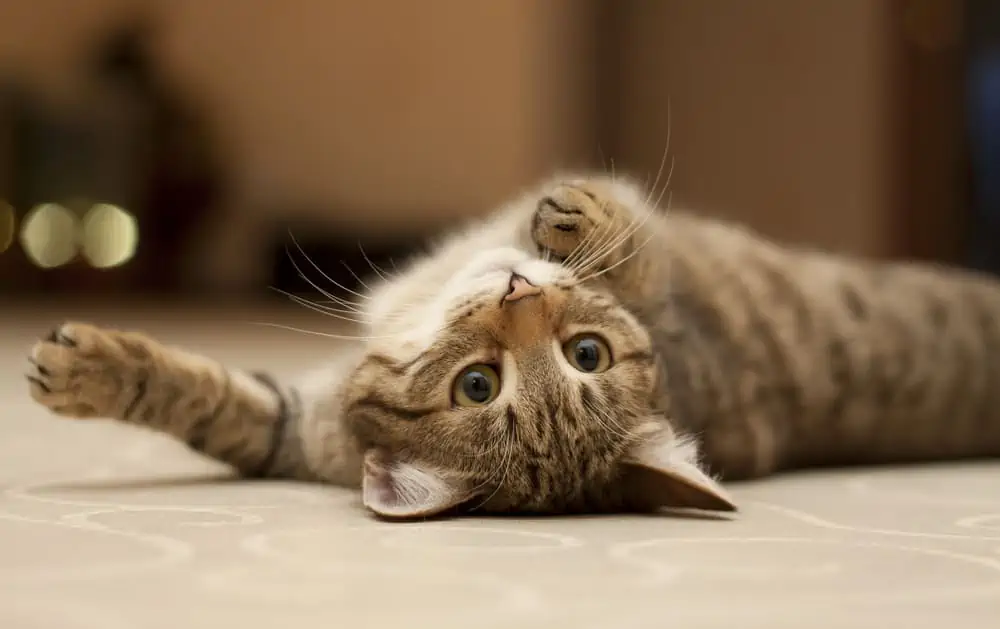You should pay attention to your cat’s noises because they can give insights into their health and behaviours. While some vocalisations are normal, sudden or unusual sounds may indicate discomfort, illness, or distress.
Continuous howling, crying, or yowling, especially during activities like urination or defecation, could signal a health issue. Monitor for changes in behaviour or vocal patterns, and contact your vet if you notice anything unusual.
Timely veterinary assessment can help address any concerns and ensure your cat’s well-being. Still, it is worth considering getting pet insurance for cats early in your pet’s life, as many pet health insurance policies do not cover preexisting medical conditions.
Contemplate signing up for one. In the meantime, read this article to decode different cat noises.
Meanings of various cat sounds
Cats communicate through various sounds, each conveying different meanings. Some common cat vocalisations and their meanings are listed below.
1. Meow
- Short meow: A casual greeting or expression of acknowledgement.
- Multiple meows: A demand for attention, often used when your cat wants something.
- High-pitched meow: An expression of excitement or discomfort.
- Low-pitched meow: A sign of annoyance or dissatisfaction.
2. Purring
- Content purring: Indicates relaxation and satisfaction.
- Purring with kneading: Often seen during nursing or when a cat is particularly comfortable.
3. Chirping or chattering
This is often observed when a cat watches birds or other prey animals. It may be a sign of excitement or frustration.
4. Hissing
A defensive sound indicating fear, anger, or discomfort. Cats may hiss to warn of potential threats.
5. Growling
Similar to hissing, growling signifies aggression or a feeling of being threatened. Cats may growl when cornered or during territorial disputes.
6. Trilling
A friendly, melodic sound expressing happiness and greeting.
7. Howling or yowling
Often associated with mating behaviour in unspayed or unneutered cats. It can also indicate distress or discomfort.
8. Screaming
An intense, loud cry is usually associated with extreme fear, pain, or a traumatic situation. Immediate attention is needed.
9. Silent meow
Some cats produce a silent meow, opening their mouth without vocalising. It’s often seen as an affectionate or pleading gesture.
10. Murmuring or muttering
Soft, almost inaudible sounds that may indicate contentment or relaxation.
Understanding these vocalisations and body language helps decipher your cat’s needs and emotions. Pay attention to the context and combine vocal cues with visual cues for a more accurate understanding of your cat’s communication.
Sounds sick cats make
When ill, cats may produce sounds like –
- Moaning or groaning: Indicates pain or discomfort.
- Hissing or growling: Defensive responses to pain or fear.
- Excessive vocalisation: Continuous meowing, yowling, or crying may signal distress.
- Gagging or choking sounds: Respiratory or digestive issues.
- Laboured breathing sounds: Wheezing or raspy breathing may indicate respiratory problems.
- Changes in purring: A decrease or absence of purring, especially during petting, may suggest pain or illness. If your cat exhibits these sounds, consult a vet promptly for proper diagnosis and treatment.
When unsure what your cat’s sounds mean, discussing the issue with your vet is best. This way, you can get down to the root cause of your feline’s distress, which could be due to potential health issues.
At the same time, consider being equipped with pet insurance for cats so that providing quality medical assistance is much easier during challenging health scenarios and medical emergencies.
Contemplate purchasing pet health insurance to assure your precious cat deserving medical care at all times.





